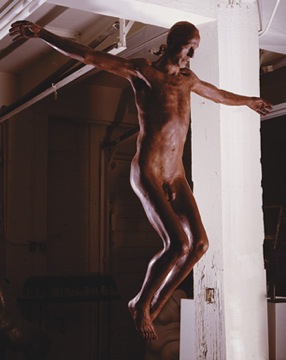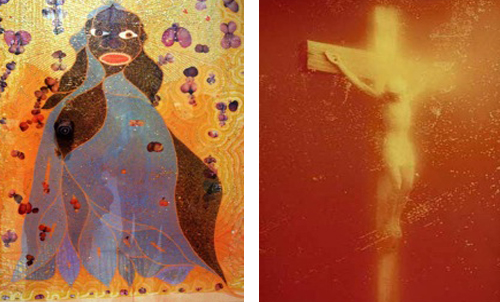
As readers’ comments suggest in the introductory post of Flash Points, contemporary art that engages religion is a hotbed for controversy. James Horn remarks, “I have seen pictures which have featured gratuitously abused religious imagery, which I am sure have been created purely for shock value.” James is right to identify this as an easy strategy to provoke a response, especially to get the attention of a broader audience, though I wonder if an artist’s intention is always that simplistic.
In 2007, a tempest erupted in New York City over the artwork pictured above, titled My Sweet Lord, by Cosimo Cavallaro. This artwork depicting Jesus Christ was sculpted from 200 pounds of chocolate. It was to be exhibited at a gallery in Midtown, looking out onto the street during Holy Week right before Easter. After an intense uproar, featuring the voices of Cardinal Edward Egan and Bill Donohue from the Catholic League, the exhibition was moved and postponed until November. In some ways this might be a prime example of what James mentions in his comment.

Chris Ofili’s Holy Virgin Mary (1999) and Andres Serrano’s Piss Christ (1987)
As a teenager, I became aware of the term ‘contemporary art’ when Rudy Giuliani went on the radio, declaring that the Brooklyn Museum’s 1999 exhibit Sensation was “disgusting,” “horrible,” and “blasphemous.” As many remember, the center of this controversy was Chris Ofili’s Holy Virgin Mary, which used elephant dung as one of many materials the artist worked with to visualize the mother of Jesus. What troubled me about this quick and “dirty” interpretation of Ofili’s work, even as a teenager, was that it erased any nuanced reading or sense of awe a viewer might experience when viewing the work.
In addition to Holy Virgin Mary, many other images have been at the center of their own controversies for showcasing religious iconography in secular way. Some of these works include Piss Christ by Andreas Serrano, Andy Warhol’s The Last Supper, and an artwork titled Desenhando em Terços by Marcia X—brought to my attention by one of our readers, Leonardo Ayres. In 2006, this work, rendering male genitals out of rosary beads, was removed from an exhibition in São Paolo because it was deemed too controversial.

Andy Warhol’s The Last Supper (1986) and Marcia X’s Desenhando em Terços (2006)
So what makes all of these images so inflammatory? Is it that religious iconography is gratuitously abused? Is it a question of the artist’s intent to offend those of faith? Is linking the sacred with the profane blasphemous? Or, is it just taking the stuff of miracles and making it mundane?




Pingback: Reflection in the Porcelain Pond | Art21 Blog
Pingback: Letter from London: Scrooged | Art21 Blog
Pingback: “I am the Invisible Being” | My Work